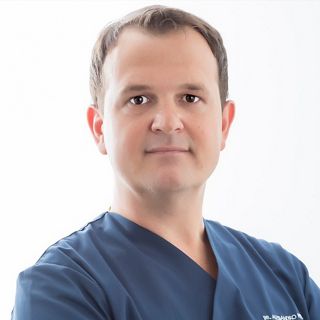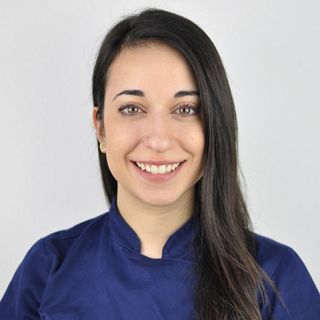
Dr. Alessandro Perucchi

Dr. Jessica Dana
Creation of an ideal emergence profile with the Straumann® Ceramic Healing Abutments – a case report
A clinical case report by Alessandro Perucchi and Jessica Dana, Switzerland
An ideal implant-prosthetic rehabilitation requires a transmucosal path in appropriate conditions. To achieve this outcome, in the following case report the use of the new Straumann® Ceramic Healing Abutments performed. These abutments offer favorable conditions for soft-tissue attachment, hereby supporting a healthy peri-implant environment. Furthermore, their well-proven zirconia material helps to reduce plaque attachment and enhance soft tissue healing.
Procedure
Treatment planning
The choice to use the new Straumann Ceramic Healing Abutments (Fig. 5) was dictated by the well-known biocompatibility of this material. The Zirconia's great properties predispose it to be a potentially ideal material in post-surgical healing, where microbial contamination can often invalidate the success of the intervention. In fact, thanks to its smooth surface, the accumulation of plaque can be significantly reduced, favoring the formation of a new peri-implant attachment.
The novelty lies in the fact that it is no longer only the prosthetic part that is created in Zirconia, but also the healing abutment. This could be a considerable help especially when the keratinized tissue around the implant needs to be increased, as the Ceramic Healing Abutment is designed to promote the development of healthy mucosa around the implant.
For the implant 13, we planned to screw a classic titanium healing abutment; while in the 23, the new ceramic healing abutment. Our choice to place the Zirconia healing abutment on 23 was dictated by the fact that the keratinized mucosa in that site was quantitatively reduced in comparison to the contralateral site (Figs. 1 and 3). The patient's thin biotype implied a greater risk in the loss of keratinized mucosa and the great biocompatibility of the zirconia can enhance and boost the keratinized tissue, which is an important and fundamental aspect in an implant-prosthetic rehabilitation.
Surgical & Prosthetic procedures
Following the local anesthesia procedures, two Bone Level Straumann ® SLA ® Roxolid ® implants of 4.1mm x 12mm were placed in positions 13 and 23. Moreover, simultaneous bone augmentation was performed in both areas using the Straumann ® Jason Membranes and a bone substitutes (Figs. 6 and 7). For the correct osseointegration of the submerged fixtures, we waited 4 months.
At the time of the second stage (Figs. 8- 10), we screwed a classic titanium healing abutment into implant 13 and a ceramic healing abutment on implant 23 (Figs. 11-14). The Ceramic Healing Abutments are composed of an external Zirconia body, while the internal part consists of a titanium screw that allows the tighten into the implant. We therefore made sure to put a chlorhexidine gel on the titanium part to avoid bacterial contamination.
Following 3 months, digital impressions were taken. The permanence of a satisfying amount of keratinized tissue around the implants was obtained thanks to the conservative surgical intervention, preserving the necessary portion of keratinized mucosa aimed to obtain good soft tissue conditions (Figs 15-18).
The final screw retained restorations were made by the referral dentist with Variobase ® abutments and Zirconia crowns.
Periapical radiographs were taken after that the final crowns were placed (Fig 19-21).
Treatment outcome
The healing and tissue maturation had given wonderful effects. Both sites obtained sufficient gingival creeping, and this was also due to the maintenance of keratinized tissue around the implants, which is an important factor in the success of the rehabilitation. In particular, we have noticed the benefits of the Zirconia on the emergence profile of the implant placed into position 23. In fact, the Ceramic Healing Abutment boosted the creation of a new and vigorous peri-implant attachment.
Furthermore, the clinical and radiographic assessments showed excellent treatment outcomes and the patient was satisfied with the result.
Findings
The new Ceramic Healing Abutment made possible to obtain a healthy and solid transgingival path to start a noteworthy implant-prosthetic rehabilitation. The antibacterial power of this material ensured an excellent and predictable result.